Improving the Altimeter-Derived Surface Currents Using Sea Surface Temperature (SST) Data: A Sensitivity Study to SST Products
Abstract
1. Introduction
2. Materials and Methods
2.1. Data
- 1.
- The altimeter-derived sea surface currents computed at CLS (the list of undefined abbreviations is available at the end of the manuscript) in the framework of the DUACS project and distributed by the CMEMS Sea Level Thematic Assembly Center: two different products were used, referred to as “2SAT” and “4SAT”. Both products are gridded data provided on a regular 1/4 grid. The 2SAT product is calculated merging observations from two altimeters: Jason-2 and AltiKa, with Jason 3 only from March 2016. The 4SAT product is obtained using a four altimeter constellation: Jason-2(3), Cryosat, Altika and HY-2A. The 4SAT dataset can be seen as the best altimeter-derived surface current estimate in the 2014-2016 period. On the other hand, the 2SAT version is less accurate, being based on observations from only two altimeters like for the altimeter-derived currents of the early altimetry era (the early 1990s) [36]. A 2SAT altimeter constellation is the minimum required for resolving the larger mesoscales circulation structures, providing spatial-temporal resolutions around 150–200 km and 10–15 days. However, merging information from four (or more) altimeters enables to improve the retrieval of mesoscale features missing in the 2SAT estimates, achieving effective spatial-temporal resolutions around 100 km and, at best, 7 days ([17,19,37], https://www.aviso.altimetry.fr);
- 2.
- The SST daily observations are the REMSS processing centre: we used the high resolution product based on the combination of microwave (from TMI, AMSR-E, AMSR2, WindSat and GMI) and infrared (Terra MODIS, Aqua MODIS, VIIRS) data. These SST observations are corrected using a diurnal model and represent a foundation SST (≃10 m depth) [38,39]. These data are calculated using an Optimal Interpolation scheme with 100 km and 4-day correlation scales and are provided on a ≃1/10 regular grid ([40], http://www.remss.com);
- 3.
- The SST daily observations from the Operational Sea Surface Temperature and Sea Ice Analysis (OSTIA) system: OSTIA uses satellite data including AMSR-E, AVHRR (GAC+LAC), IASI, SEVIRI, TMI, GOES, SSMIS, SSM/I sensors together with in-situ observations to determine the sea surface temperature [41,42]. The analysis is performed using the optimal interpolation (OI) scheme described by [43]. The analysis is produced daily and is provided on a 1/20 regular grid;
- 4.
- The Multiscale Ultra-high Resolution global SST analyses (MUR): such SST dataset relies on high and low resolution satellite observations in the microwave and infrared bands (e.g., from AMSR-E, AMSR-2, WindSat, AVHRR, MODIS). The satellite data are also merged with in-situ SST estimates via a Multiresolution Variational Analysis Method [44]. The analysis is produced daily and is provided on a 1/100 regular grid;
- 5.
- The in-situ derived sea surface currents (at 15 m depth) measured by SVP-type drogued drifting buoys: Such quality-controlled, six-hourly data are available from the NOAA AOML Surface Drifter Data Assembly Center ([45], https://www.aoml.noaa.gov/phod/gdp/).
2.2. Methods: The Optimal Reconstruction
2.3. Optimal Reconstruction Validation Metrics
3. Results
3.1. Reconstruction Based on REMSS Data
3.2. Reconstruction Based on OSTIA Data
3.3. Reconstruction Based on MUR Data
4. Discussion and Conclusions
- The derivation of the sea surface currents from space can benefit from the synergy between optimally interpolated space-based Earth observations from multiple platforms, today available at an operational level and with nominal daily and global coverage. Based on recent works [33,47] we attempted to optimize the surface currents retrieval by combining the altimeter-derived geostrophic currents with satellite SST from Infrared (IR) and Microwave (MW) sensors. Our study was based on three different L4 SST estimates: a dataset provided by Remote Sensing Systems, fully based on the optimal interpolation of satellite observations (IR and MW), and two additional datasets based on the optimal interpolation of satellite and in-situ data, i.e., the OSTIA and MUR SSTs.
- The REMSS and OSTIA OPC exhibited the best performances, with maximum overall improvements equal to or larger than 15% with respect to the geostrophic estimates (for the meridional flow). This was achieved transferring the high resolution dynamical content of the satellite-derived SST into the coarser resolution geostrophic current estimates [33,34]. However, the OSTIA OPC are characterized by larger improvements than the REMSS OPC in the 0.2 to 4 C· m|∇SST| range. This result is due to enhanced performances of the OSTIA OPC in the 45S to 70S latitudinal band. This is illustrated by Figure 1, Figure 2 and Figure 4 and summarized by Table 1: the OSTIA OPC partially solve the degradation of the zonal flow in the Southern Ocean, also yielding slightly larger averaged PIs for the meridional flow.Most likely, this is due to the larger number of sensors used to build the L4 SSTs as well as the use of in-situ observations in the optimal interpolation procedure. This could optimize the SST estimates at high latitudes, where cloud coverage is often very high and where average intense surface winds degrade the satellite infrared and microwave SST retrievals [51,52]. An additional analysis is provided as Supplementary Materials (Figure S5).However, despite the improved performances of the OSTIA OPC compared to the REMSS case, occasional degradations in the polar regions can also occur with the OSTIA SST, as shown in Figure 2. This emphasizes the importance of providing very high quality, high resolution and synoptic SST measurements in those areas, highlighting the strong potential of future ESA satellite missions like the Copernicus Imaging Microwave Radiometer (CIMR) [53] (https://cimr.eu). CIMR will provide global-scale, all-weather, 15 km effective spatial resolution SST observations, also guaranteeing sub-daily coverage at latitudes higher than ±60. All the SST-based applications will benefit from the future CIMR remote sensing capabilities. Applying the RS18 method in high-latitude areas could also benefit from additional oceanic tracers as sea surface salinity. In polar areas, the contribution of salinity in determining the ocean dynamics can be relevant [54].
- The OPC based on the use of MUR very high resolution data, though showing degraded performances at global scale, suggest that fine-scale SST gradients can be retrieved successfully. This is achieved when the MUR SST effective high resolution is homogenous in the study area, mostly indicating a potential for local applications.
Supplementary Materials
Author Contributions
Funding
Acknowledgments
Conflicts of Interest
Abbreviations
| ADCP | Acoustic Doppler Current Profiler |
| AMSR-E | Advanced Microwave Scanning Radiometer - Earth Observing System |
| AMSR-2 | Second Advanced Microwave Scanning Radiometer |
| AVHRR | Advanced Very-High-Resolution Radiometer |
| AVHRR-GAC | Advanced Very-High-Resolution Radiometer - Global Area Coverage |
| AVHRR-LAC | Advanced Very-High-Resolution Radiometer - Local Area coverage |
| CLS | Collecte Localisation Satellites |
| DUACS | Data Unification and Altimeter Combination System |
| ESA | European Space Agency |
| HY2A | Haiyang-2A satellite |
| MODIS | Moderate-resolution Imaging Spectroradiometer |
| NOAA AOML | National Oceanic and Atmospheric Administration—Atlantic Oceanographic and Meteorological Laboratory |
| SVP | Surface Velocity Program |
| TMI | Tropical Rainfall Measuring Mission Microwave Imager |
| L4 | Level 4 processing analysis |
| SSM/I | Special Sensor Microwave/Imager |
| SSMIS | Special Sensor Microwave Imager Sounder |
| VIIRS | Visible Infrared Imaging Radiometer Suite (VIIRS) |
References
- Hátún, H.; Sandø, A.B.; Drange, H.; Hansen, B.; Valdimarsson, H. Influence of the Atlantic subpolar gyre on the thermohaline circulation. Science 2005, 309, 1841–1844. [Google Scholar] [CrossRef] [PubMed]
- Bashmachnikov, I.; Neves, F.; Calheiros, T.; Carton, X. Properties and pathways of Mediterranean water eddies in the Atlantic. Prog. Oceanogr. 2015, 137, 149–172. [Google Scholar] [CrossRef]
- Buongiorno Nardelli, B. Vortex waves and vertical motion in a mesoscale cyclonic eddy. J. Geophys. Res. Ocean. 2013, 118, 5609–5624. [Google Scholar] [CrossRef]
- Barbosa Aguiar, A.C.; Peliz, Á.; Carton, X. A census of Meddies in a long-term high-resolution simulation. Prog. Oceanogr. 2013, 116, 80–94. [Google Scholar] [CrossRef]
- Ponte, A.; Klein, P.; Capet, X.; Le Traon, P.; Chapron, B.; Lherminier, P. Diagnosing surface mixed layer dynamics from high-resolution satellite observations: Numerical insights. J. Phys. Oceanogr. 2013, 43, 1345–1355. [Google Scholar] [CrossRef]
- Frenger, I.; Gruber, N.; Knutti, R.; Munnich, M. Imprint of Southern Ocean eddies on winds, clouds and rainfall. Nat. Geosci. 2013, 6, 608–612. [Google Scholar] [CrossRef]
- Chenillat, F.; Franks, P.J.; Combes, V. Biogeochemical properties of eddies in the California Current System. Geophys. Res. Lett. 2016, 43, 5812–5820. [Google Scholar] [CrossRef]
- Siokou-Frangou, I.; Christaki, U.; Mazzocchi, M.G.; Montresor, M.; Ribera d’Alcalá, M.; Vaqué, D.; Zingone, A. Plankton in the open Mediterranean Sea: A review. Biogeosciences 2010, 7, 1543–1586. [Google Scholar] [CrossRef]
- Olascoaga, M.J.; Beron-Vera, F.J.; Haller, G.; Trinanes, J.; Iskandarani, M.; Coelho, E.; Haus, B.K.; Huntley, H.; Jacobs, G.; Kirwan, A.; et al. Drifter motion in the Gulf of Mexico constrained by altimetric Lagrangian coherent structures. Geophys. Res. Lett. 2013, 40, 6171–6175. [Google Scholar] [CrossRef]
- Clarke, A.; Li, J. El Nino/La Nina shelf edge flow and Australian western rock lobsters. Geophys. Res. Lett. 2004, 31. [Google Scholar] [CrossRef]
- Li, J.; Clarke, A.J. Coastline direction, interannual flow, and the strong El Niño currents along Australia’s nearly zonal southern coast. J. Phys. Oceanogr. 2004, 34, 2373–2381. [Google Scholar] [CrossRef]
- Carlson, D.F.; Clarke, A.J. Seasonal along-isobath geostrophic flows on the west Florida shelf with application to Karenia brevis red tide blooms in Florida’s Big Bend. Cont. Shelf Res. 2009, 29, 445–455. [Google Scholar] [CrossRef]
- Pisano, A.; De Dominicis, M.; Biamino, W.; Bignami, F.; Gherardi, S.; Colao, F.; Coppini, G.; Marullo, S.; Sprovieri, M.; Trivero, P.; et al. An oceanographic survey for oil spill monitoring and model forecasting validation using remote sensing and in situ data in the Mediterranean Sea. Deep Sea Res. Part II Top. Stud. Oceanogr. 2016, 133, 132–145. [Google Scholar] [CrossRef]
- Onink, V.; Wichmann, D.; Delandmeter, P.; Van Sebille, E. The role of Ekman currents, geostrophy, and Stokes drift in the accumulation of floating microplastic. J. Geophys. Res. Ocean. 2019, 124, 1474–1490. [Google Scholar] [CrossRef]
- Cazenave, A.; Palanisamy, H.; Ablain, M. Contemporary sea level changes from satellite altimetry: What have we learned? What are the new challenges? Adv. Space Res. 2018, 62, 1639–1653. [Google Scholar] [CrossRef]
- Vallis, G.K. Atmospheric and Oceanic Fluid Dynamics; Cambridge University Press: Cambridge, UK, 2006; p. 745. [Google Scholar]
- Pujol, M.I.; Dibarboure, G.; Le Traon, P.Y.; Klein, P. Using high-resolution altimetry to observe mesoscale signals. J. Atmos. Ocean. Technol. 2012, 29, 1409–1416. [Google Scholar] [CrossRef]
- Pujol, M.I.; Faugère, Y.; Taburet, G.; Dupuy, S.; Pelloquin, C.; Ablain, M.; Picot, N. DUACS DT2014: The new multi-mission altimeter data set reprocessed over 20 years. Ocean. Sci. 2016, 12, 1067–1090. [Google Scholar] [CrossRef]
- Ballarotta, M.; Ubelmann, C.; Pujol, M.I.; Taburet, G.; Fournier, F.; Legeais, J.F.; Faugère, Y.; Delepoulle, A.; Chelton, D.; Dibarboure, G.; et al. On the resolutions of ocean altimetry maps. Ocean. Sci. 2019, 15, 1091–1109. [Google Scholar] [CrossRef]
- Chapron, B.; Collard, F.; Ardhuin, F. Direct measurements of ocean surface velocity from space: Interpretation and validation. J. Geophys. Res. Ocean. 2005, 110. [Google Scholar] [CrossRef]
- Poulain, P.M. Adriatic Sea surface circulation as derived from drifter data between 1990 and 1999. J. Mar. Syst. 2001, 29, 3–32. [Google Scholar] [CrossRef]
- Falco, P.; Zambianchi, E. Near-surface structure of the Antarctic Circumpolar Current derived from World Ocean Circulation Experiment drifter data. J. Geophys. Res. Ocean. 2011, 116, C05003. [Google Scholar] [CrossRef]
- Lumpkin, R.; Özgökmen, T.; Centurioni, L. Advances in the application of surface drifters. Annu. Rev. Mar. Sci. 2017, 9, 59–81. [Google Scholar] [CrossRef] [PubMed]
- Laurindo, L.C.; Mariano, A.J.; Lumpkin, R. An improved near-surface velocity climatology for the global ocean from drifter observations. Deep Sea Res. Part I Oceanogr. Res. Pap. 2017, 124, 73–92. [Google Scholar] [CrossRef]
- Capodici, F.; Cosoli, S.; Ciraolo, G.; Nasello, C.; Maltese, A.; Poulain, P.M.; Drago, A.; Azzopardi, J.; Gauci, A. Validation of HF radar sea surface currents in the Malta-Sicily Channel. Remote Sens. Environ. 2019, 225, 65–76. [Google Scholar] [CrossRef]
- Berta, M.; Griffa, A.; Magaldi, M.G.; Özgökmen, T.M.; Poje, A.C.; Haza, A.C.; Olascoaga, M.J. Improved surface velocity and trajectory estimates in the Gulf of Mexico from blended satellite altimetry and drifter data. J. Atmos. Ocean. Technol. 2015, 32, 1880–1901. [Google Scholar] [CrossRef]
- Mulet, S.; Etienne, H.; Ballarotta, M.; Faugere, Y.; Rio, M.; Dibarboure, G.; Picot, N. Synergy between surface drifters and altimetry to increase the accuracy of sea level anomaly and geostrophic current maps in the Gulf of Mexico. Adv. Space Res. 2020. [Google Scholar] [CrossRef]
- Isern-Fontanet, J.; Chapron, B.; Lapeyre, G.; Klein, P. Potential use of microwave sea surface temperatures for the estimation of ocean currents. Geophys. Res. Lett. 2006, 33. [Google Scholar] [CrossRef]
- González-Haro, C.; Isern-Fontanet, J. Global ocean current reconstruction from altimetric and microwave SST measurements. J. Geophys. Res. Ocean. 2014, 119, 3378–3391. [Google Scholar] [CrossRef]
- Bowen, M.M.; Emery, W.J.; Wilkin, J.L.; Tildesley, P.C.; Barton, I.J.; Knewtson, R. Extracting multiyear surface currents from sequential thermal imagery using the maximum cross-correlation technique. J. Atmos. Ocean. Technol. 2002, 19, 1665–1676. [Google Scholar] [CrossRef]
- Qazi, W.A.; Emery, W.J.; Fox-Kemper, B. Computing ocean surface currents over the coastal California current system using 30-min-lag sequential SAR images. IEEE Trans. Geosci. Remote. Sens. 2014, 52, 7559–7580. [Google Scholar] [CrossRef]
- Warren, M.; Quartly, G.; Shutler, J.; Miller, P.; Yoshikawa, Y. Estimation of ocean surface currents from maximum cross correlation applied to GOCI geostationary satellite remote sensing data over the Tsushima (Korea) Straits. J. Geophys. Res. Ocean. 2016, 121, 6993–7009. [Google Scholar] [CrossRef]
- Rio, M.H.; Santoleri, R. Improved global surface currents from the merging of altimetry and Sea Surface Temperature data. Remote Sens. Environ. 2018, 216, 770–785. [Google Scholar] [CrossRef]
- Piterbarg, L.I. A simple method for computing velocities from tracer observations and a model output. Appl. Math. Model. 2009, 33, 3693–3704. [Google Scholar] [CrossRef]
- Mercatini, A.; Griffa, A.; Piterbarg, L.; Zambianchi, E.; Magaldi, M.G. Estimating surface velocities from satellite data and numerical models: Implementation and testing of a new simple method. Ocean. Model. 2010, 33, 190–203. [Google Scholar] [CrossRef]
- Taburet, G.; Sanchez-Roman, A.; Ballarotta, M.; Pujol, M.I.; Legeais, J.F.; Fournier, F.; Faugere, Y.; Dibarboure, G. DUACS DT2018: 25 years of reprocessed sea level altimetry products. Ocean Sci. 2019, 15, 1207–1224. [Google Scholar] [CrossRef]
- Pascual, A.; Faugère, Y.; Larnicol, G.; Le Traon, P.Y. Improved description of the ocean mesoscale variability by combining four satellite altimeters. Geophys. Res. Lett. 2006, 33. [Google Scholar] [CrossRef]
- Gentemann, C.L.; Donlon, C.J.; Stuart-Menteth, A.; Wentz, F.J. Diurnal signals in satellite sea surface temperature measurements. Geophys. Res. Lett. 2003, 30. [Google Scholar] [CrossRef]
- Martin, M.; Dash, P.; Ignatov, A.; Banzon, V.; Beggs, H.; Brasnett, B.; Cayula, J.F.; Cummings, J.; Donlon, C.; Gentemann, C.; et al. Group for High Resolution Sea Surface temperature (GHRSST) analysis fields inter-comparisons. Part 1: A GHRSST multi-product ensemble (GMPE). Deep Sea Res. Part II Top. Stud. Oceanogr. 2012, 77, 21–30. [Google Scholar] [CrossRef]
- Gentemann, C.L.; Meissner, T.; Wentz, F.J. Accuracy of satellite sea surface temperatures at 7 and 11 GHz. IEEE Trans. Geosci. Remote. Sens. 2009, 48, 1009–1018. [Google Scholar] [CrossRef]
- Donlon, C.J.; Martin, M.; Stark, J.; Roberts-Jones, J.; Fiedler, E.; Wimmer, W. The operational sea surface temperature and sea ice analysis (OSTIA) system. Remote Sens. Environ. 2012, 116, 140–158. [Google Scholar] [CrossRef]
- Good, S.; Fiedler, E.; Mao, C.; Martin, M.J.; Maycock, A.; Reid, R.; Roberts-Jones, J.; Searle, T.; Waters, J.; While, J.; et al. The Current Configuration of the OSTIA System for Operational Production of Foundation Sea Surface Temperature and Ice Concentration Analyses. Remote. Sens. 2020, 12, 720. [Google Scholar] [CrossRef]
- Martin, M.; Hines, A.; Bell, M. Data assimilation in the FOAM operational short-range ocean forecasting system: A description of the scheme and its impact. Q. J. R. Meteorol. Soc. 2007, 133, 981–995. [Google Scholar] [CrossRef]
- Chin, T.M.; Vazquez-Cuervo, J.; Armstrong, E.M. A multi-scale high-resolution analysis of global sea surface temperature. Remote. Sens. Environ. 2017, 200, 154–169. [Google Scholar] [CrossRef]
- Lumpkin, R.; Grodsky, S.A.; Centurioni, L.; Rio, M.H.; Carton, J.A.; Lee, D. Removing spurious low-frequency variability in drifter velocities. J. Atmos. Ocean. Technol. 2013, 30, 353–360. [Google Scholar] [CrossRef]
- Rio, M.H.; Santoleri, R.; Bourdalle-Badie, R.; Griffa, A.; Piterbarg, L.; Taburet, G. Improving the Altimeter-Derived Surface Currents Using High-Resolution Sea Surface Temperature Data: A Feasability Study Based on Model Outputs. J. Atmos. Ocean. Technol. 2016, 33, 2769–2784. [Google Scholar] [CrossRef]
- Ciani, D.; Rio, M.H.; Menna, M.; Santoleri, R. A Synergetic Approach for the Space-Based Sea Surface Currents Retrieval in the Mediterranean Sea. Remote. Sens. 2019, 11, 1285. [Google Scholar] [CrossRef]
- Vazquez-Cuervo, J.; Gomez-Valdes, J.; Bouali, M.; Miranda, L.E.; Van der Stocken, T.; Tang, W.; Gentemann, C. Using saildrones to validate satellite-derived sea surface salinity and sea surface temperature along the California/Baja Coast. Remote. Sens. 2019, 11, 1964. [Google Scholar] [CrossRef]
- Callies, J.; Ferrari, R.; Klymak, J.M.; Gula, J. Seasonality in submesoscale turbulence. Nat. Commun. 2015, 6, 6862. [Google Scholar] [CrossRef]
- Chelton, D.; De Szoeke, R.; Schlax, M.; El Naggar, K.; Siwertz, N. Geographical Variability of the First Baroclinic Rossby Radius of Deformation. J. Phys. Oceanogr. 1998, 28, 433–459. [Google Scholar] [CrossRef]
- González-Haro, C.; Autret, A.P. Quantifying Tidal Fluctuations in Remote Sensing Infrared SST Observations. Remote. Sens. 2019, 11, 2313. [Google Scholar] [CrossRef]
- Wentz, F.; Meissner, T.; Gentemann, C.; Hilburn, K.; Scott, J. Remote Sensing Systems GCOM-W1 AMSR2 Daily Data, Environmental Suite on 0.25 Degrees Grid, 2014, Version V.8. Available online: www.remss.com/missions/amsr (accessed on 1 February 2020).
- Donlon, C.J. Copernicus Imaging Microwave Radiometer (CIMR) Mission Requirements Document; Version 3.0; European Space Agency: Noordwijk, The Netherlands, 2019. [Google Scholar]
- Roquet, F.; Madec, G.; Brodeau, L.; Nycander, J. Defining a simplified yet realistic equation of state for seawater. J. Phys. Ocean. 2015, 45, 2564–2579. [Google Scholar] [CrossRef]
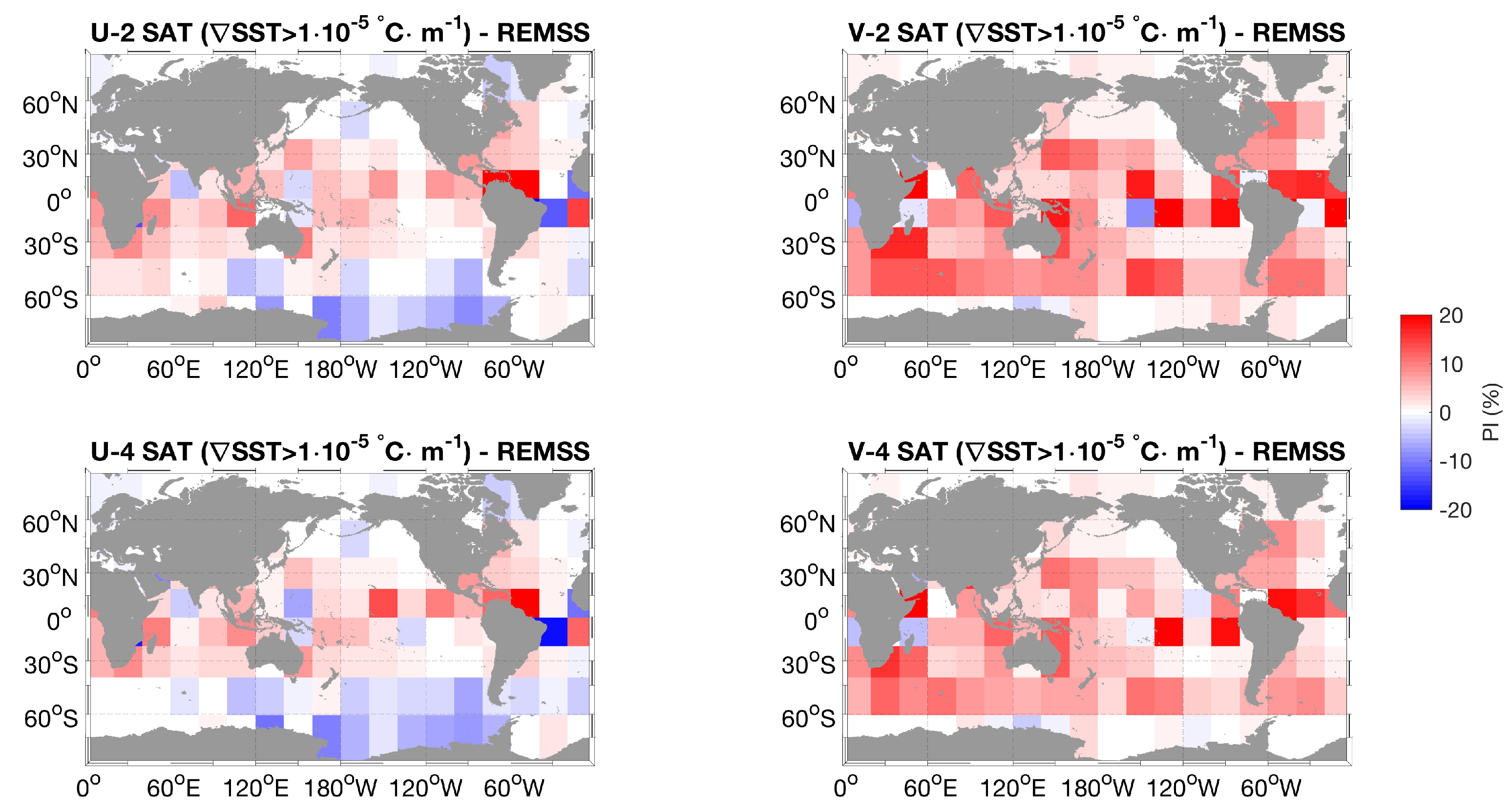
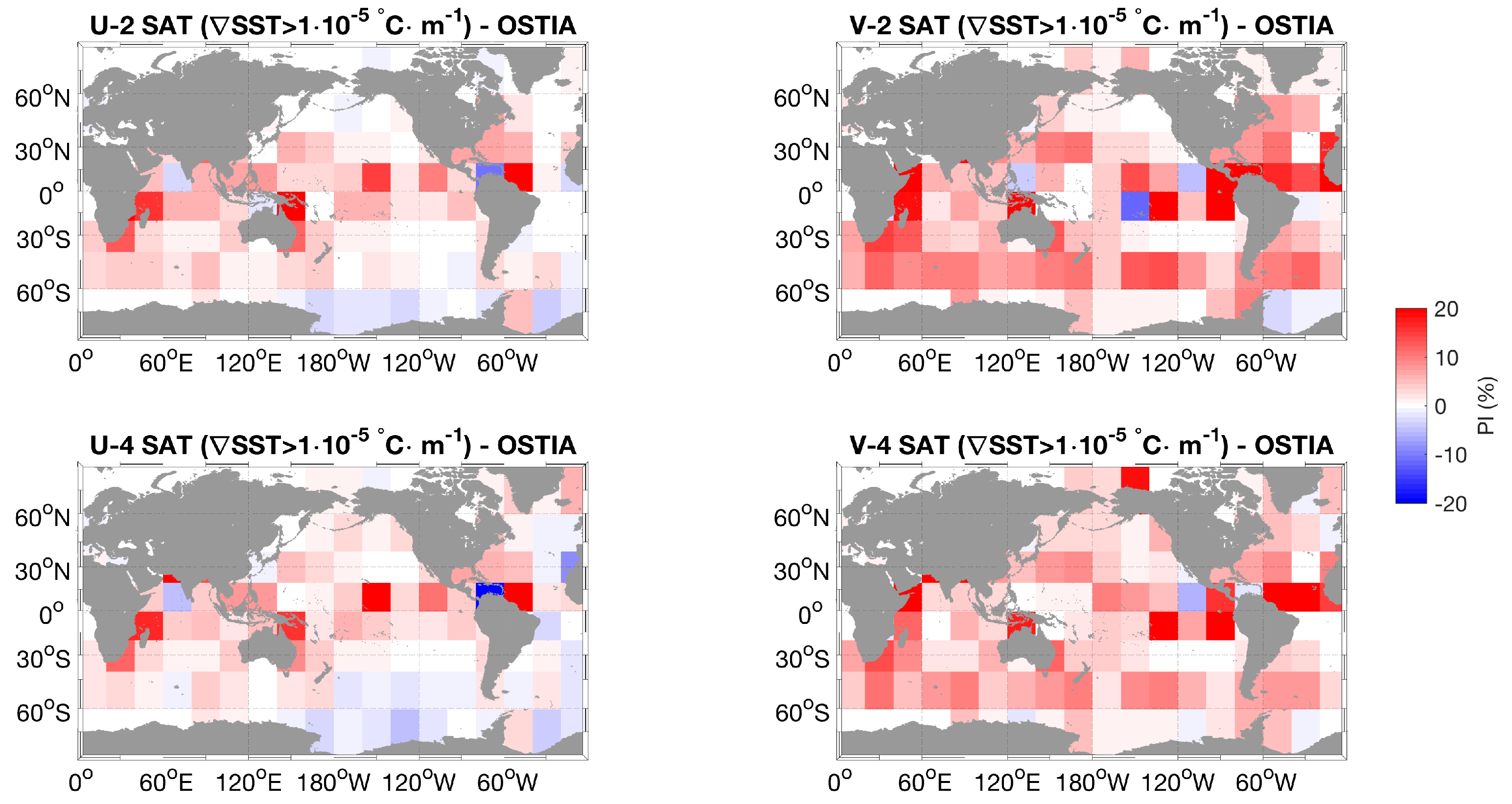


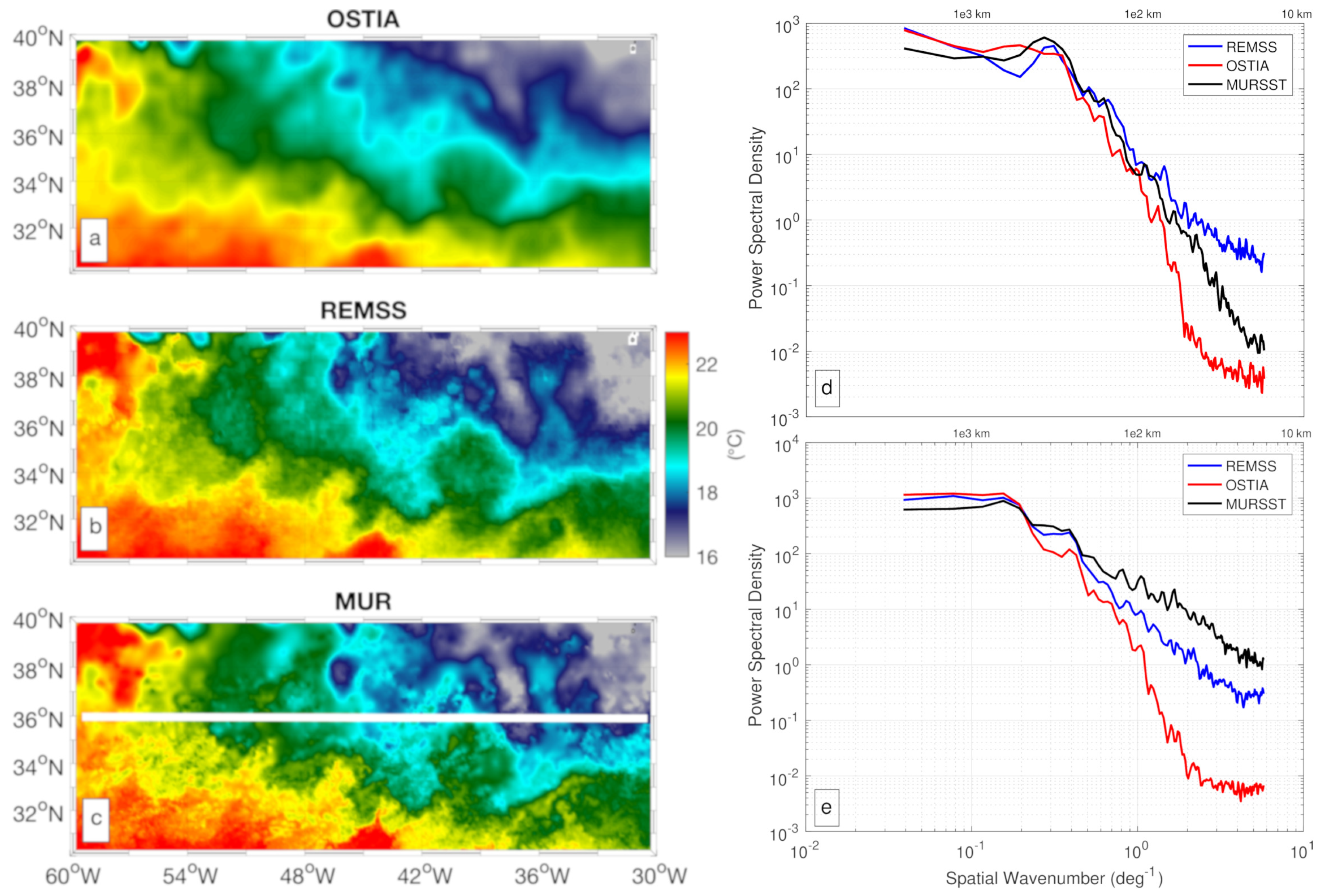
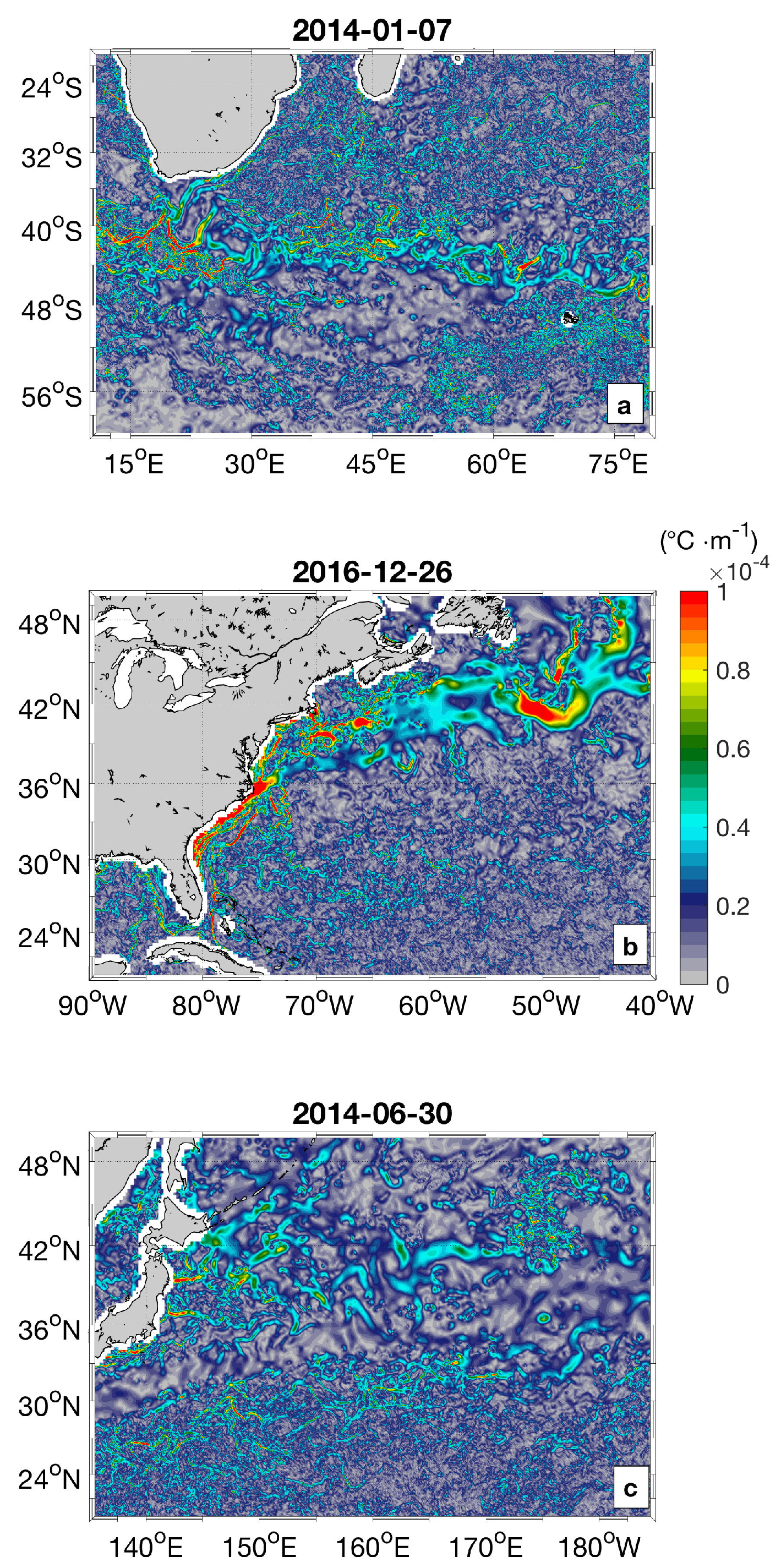
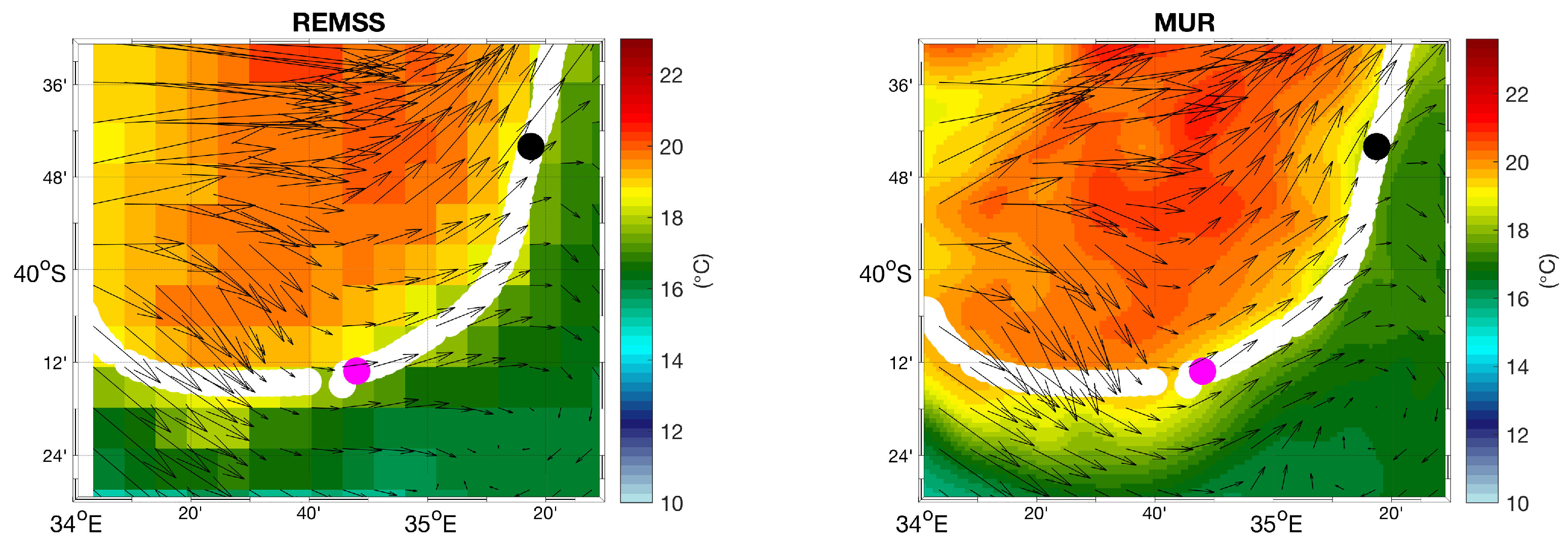
| 45S–70S | REMSS | OSTIA |
|---|---|---|
| 2SAT - ZONAL PI (%) | −1.35 | 1.34 |
| 2SAT - MERIDIONAL PI (%) | 5.60 | 6.43 |
| 4SAT - ZONAL PI (%) | −2.48 | 0.10 |
| 4SAT - MERIDIONAL PI (%) | 4.28 | 4.61 |
© 2020 by the authors. Licensee MDPI, Basel, Switzerland. This article is an open access article distributed under the terms and conditions of the Creative Commons Attribution (CC BY) license (http://creativecommons.org/licenses/by/4.0/).
Share and Cite
Ciani, D.; Rio, M.-H.; Nardelli, B.B.; Etienne, H.; Santoleri, R. Improving the Altimeter-Derived Surface Currents Using Sea Surface Temperature (SST) Data: A Sensitivity Study to SST Products. Remote Sens. 2020, 12, 1601. https://doi.org/10.3390/rs12101601
Ciani D, Rio M-H, Nardelli BB, Etienne H, Santoleri R. Improving the Altimeter-Derived Surface Currents Using Sea Surface Temperature (SST) Data: A Sensitivity Study to SST Products. Remote Sensing. 2020; 12(10):1601. https://doi.org/10.3390/rs12101601
Chicago/Turabian StyleCiani, Daniele, Marie-Hélène Rio, Bruno Buongiorno Nardelli, Hélène Etienne, and Rosalia Santoleri. 2020. "Improving the Altimeter-Derived Surface Currents Using Sea Surface Temperature (SST) Data: A Sensitivity Study to SST Products" Remote Sensing 12, no. 10: 1601. https://doi.org/10.3390/rs12101601
APA StyleCiani, D., Rio, M.-H., Nardelli, B. B., Etienne, H., & Santoleri, R. (2020). Improving the Altimeter-Derived Surface Currents Using Sea Surface Temperature (SST) Data: A Sensitivity Study to SST Products. Remote Sensing, 12(10), 1601. https://doi.org/10.3390/rs12101601








